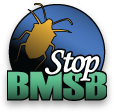Scientists Gather, Share Updates on Spread of Stink Bugs
 |
|
Adult brown marmorated stink bugs. Source: Gary Bernon, USDA APHIS, Bugwood.org. |
July 21, 2016
The Brown Marmorated Stink Bug Working Group Meeting was organized as a conference with presentations—however, as a working group, scientists frequently conversed and discussed topics during and after updates. Below, we give highlights and summaries of the presentations.
About thirty scientists gathered recently in New Brunswick, New Jersey, in a meeting sponsored by the Northeastern IPM Center, and discussed the persistent, steady spread of the brown marmorated stink bug (BMSB).
The scientists updated the official map of the BMSB invasion: The pest has been detected in North Dakota. In South Carolina and Alabama, the invader has been newly causing agricultural and nuisance problems.
George Hamilton of Rutgers University said that recent experiences with BMSB in the Northeast Region are steady compared with previous years.
However, Glynn Tillman of Cornell University gave an update on how BMSB is advancing in the Southern Region.
“Monitoring for BMSB is critically important right now,” she said.
A Southern Region BMSB Working Group has formed. Mike Toews of the University of Georgia is working with her on many tasks, such as producing a detailed phenology map. This map shows where stink bugs are located and tracks the life stages in which they were found, whether eggs, nymphs, or adults.
Tillman believes recreational vehicles (RVs) are a significant factor in stink bug spread.
Unlike in the Northeast coastal plain, BMSB do seem to be establishing in the coastal plain of Georgia. Weather differences might explain their spread there.
Pecan and cotton growers take note: BMSB damages these valuable crops. Tillman said this information comes from research by Jim Walgenbach of North Carolina State University.
Celeste Welty of Ohio State University gave an update on BMSB in the Midwest. There’s been a slow, steady spread of BMSB in Ohio, and the situation in this state may give an indication of what’s to come throughout the Midwest. The bug is found primarily in buildings and cargo, with little crop damage yet in most states.
Chuck Ingels of the University of California delivered a Western Region update. Utah in 2015 saw wider trapping for the insect and also bigger populations, leading to an overall big increase in trap catches. Commuting areas around Sacramento, California, saw continued stink bug activity. People commute into Sacramento and then bring the bugs with them to outlying areas. BMSB have established in an area of downtown Sacramento where there are many trees and parks, and where one finds tree of heaven, a known BMSB preferred host for reproduction and food.
Ingels stated that he has observed stink bugs feeding on tree trunks in very hot weather, he believes, to draw a liquid that keeps them cool.
Vincent Lesieur, of USDA Agricultural Research Service, European Biocontrol, delivered a presentation on how molecular DNA studies can be used to identify and perhaps better manage different genetic strains of stink bugs around the United States.
Kim Hoelmer of USDA Agricultural Research Service, Beneficial Insects Introduction Research, reported that the Trissolcus japonicus parasitoid wasp is now found in the wild in Maryland, District of Columbia, Virginia, on the east coast of Delaware, and west coast of Washington. He pointed out that, in terms of biological control of stink bugs, at the moment, predation is more important than parasitism, but this could change.
Ana Legrand of the University of Connecticut is studying stink bug survival on different diets, useful information for raising stink bug colonies. Her conclusion at present is that a diet of bean and carrot is best for rearing stink bugs.
Rob Morrison of USDA Agricultural Research Service presented an interesting discussion of stink bugs’ natural enemies in people’s homes that are used as overwintering sites. He found that spiders, mice, and house centipedes preyed on stink bugs. In particular, the spiders Theridiidae, Pholcidae, and Agelenidae were the most effective predators of stink bugs. In general, the cobweb spinners were the most effective predators.
Don Weber of USDA Agricultural Research Service reported that, in a study of biological control by parasitoids of stink bugs, parasitoids emerged ten percent of the time in all habitats and egg types from parasitized eggs made from sentinel egg masses. This information gives scientists a better understanding of the potential a biocontrol program could have. Trissolcus japonicus, a parasitoid of stink bug eggs, adventive from Asia, overwintered successfully in his region of study, the Northeastern United States.
Unfortunately, Trissolcus japonicus also attacks the eggs of Podisus maculiventris, the spined soldier bug, a generalist predator that also happens to be an enemy of BMSB.
Weber tested many different types of parasitoids. He believes we underestimate the extent of parasitism in sentinel egg masses.
In all, it was a very informative meeting where many experts presented interesting new information about management and ecology of brown marmorated stink bug.
Correction: An earlier version of this article incorrectly stated that BMSB damages citrus and avocado. Damage to fruit in avocado and citrus orchards has not yet been evaluated. BMSB readily feed on avocado in the lab and they have been observed feeding on damaged citrus fruit in a garden, but these findings do not indicate their potential for damage or economic harm in orchards.
— by CHRIS GONZALES
StopBMSB.org provides information about our team's efforts to control brown marmorated stink bug (BMSB), through funds provided by the USDA's Specialty Crop Research Initiative. If republishing our news, please acknowledge the source ("From StopBMSB.org") along with a link to our website.
